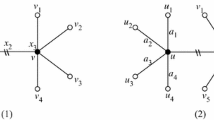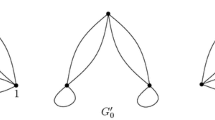Abstract
Let G be a graph whose each component has order at least 3. Let \(s : E(G) \rightarrow {\mathbb {Z}}_k\) for some integer \(k\ge 2\) be an improper edge coloring of G (where adjacent edges may be assigned the same color). If the induced vertex coloring \(c : V (G) \rightarrow {\mathbb {Z}}_k\) defined by \(c(v) = \sum _{e\in E_v} s(e) \text{ in } {\mathbb {Z}}_k,\) (where the indicated sum is computed in \({\mathbb {Z}}_k\) and \(E_v\) denotes the set of all edges incident to v) results in a proper vertex coloring of G, then we refer to such a coloring as an improper twin k-edge coloring. The minimum k for which G has an improper twin k-edge coloring is called the improper twin chromatic index of G and is denoted by \(\chi '_{it}(G)\). It is known that \(\chi '_{it}(G)=\chi (G)\), unless \(\chi (G) \equiv 2 \pmod 4\) and in this case \(\chi '_{it}(G)\in \{\chi (G), \chi (G)+1\}\). In this paper, we first give a short proof of this result and we show that if G admits an improper twin k-edge coloring for some positive integer k, then G admits an improper twin t-edge coloring for all \(t\ge k\); we call this the monotonicity property. In addition, we provide a linear time algorithm to construct an improper twin edge coloring using at most \(k+1\) colors, whenever a k-vertex coloring is given. Then we investigate, to the best of our knowledge the first time in literature, the complexity of deciding whether \(\chi '_{it}(G)=\chi (G)\) or \(\chi '_{it}(G)=\chi (G)+1\), and we show that, just like in case of the edge chromatic index, it is NP-hard even in some restricted cases. Lastly, we exhibit several classes of graphs for which the problem is polynomial.



Similar content being viewed by others
Notes
We use the term “improper twin chromatic index” following the terminology in [2] since it allows us to distinguish between the proper and the improper cases.
References
Addario-Berry, L., Aldred, R.E.L., Dalal, K., Reed, B.A.: Vertex colouring edge partitions. J. Comb. Theory (B) 94, 237–244 (2005)
Andrews, E., Helenius, L., Johnston, D., VerWys, J., Zhang, Ping: On twin edge colorings of graphs. Discuss. Math. Graph Theory 34, 613–627 (2014)
Anholcer, M., Cichacz, S.: Group sum chromatic number of graphs. Eur. J. Comb. 55, 73–81 (2016)
Anholcer, M., Cichacz, S., Milanic̆, M.: Group irregularity strength of connected graphs. J. Comb. Optim. 30(1), 1–17 (2015)
Appel, K., Haken, W.: The solution of the four-color map problem. Sci. Amer. 237, 108–121 (1977)
Brooks, R.L.: On colouring the nodes of a network. Math. Proc. Camb. Philos. Soc. 37, 194–197 (1941)
Chartrand, G., Zhang, P.: Chromatic Graph Theory. CRC Press, Boca Raton (2008)
Clarke, G., Demange, M., Roshchina, V.: Lecture Notes-Discrete Mathematics, RMIT University
Edwards, K., Hornák, M., Wozniak, M.: On the neighbour-distinguishing index of a graph. Graphs Comb. 22, 341–350 (2006)
Flandrin, E., Marczyk, A., Przybyło, J., Saclé, J.-F., Woźniak, M.: Neighbor sum distinguishing index. Graphs Comb. 29, 1329–1336 (2013)
Garey, M.R., Johnson, D.S.: Computers and Intractability, a Guide to the Theory of \(\cal{NP}\)-Completeness. Freeman, New York (1979)
Golumbic, M.C.: Algorithmic Graph Theory and Perfect Graphs, Computer Science and Applied Mathematics. Academic Press, New York (1980)
Jones, R., Kolasinski, K., Okamoto, F., Zhang, P.: Modular neighbor-distinguishing edge colorings of graphs. J. Combin. Math. Combin. Comput. 76, 159–175 (2011)
Jones, R., Kolasinski, K., Okamoto, F., Zhang, P.: On modular chromatic indexes of graphs. J. Combin. Math. Combin. Comput. 82, 295–306 (2012)
Karonski, M., Luczak, T., Thomason, A.: Edge weights and vertex colours. J. Combin. Theory (B) 91, 151–157 (2004)
Kratsch, D., Stewart, L.: Domination on cocomparability graphs. SIAM J. Discret. Math. 6, 400–417 (1993)
Robertson, N., Sanders, D.P., Seymour, P., Thomas, R.: Efficiently four-coloring planar graphs. In: Proceedings of the twenty-eighth annual ACM symposium on Theory of computing, pp. 571–575, ACM (1996)
Seamone, B.: The 1-2-3 Conjecture and related problems: a survey. arXiv:1211.5122 [math.CO] (2012) (Preprint)
Zhang, P.: Color-Induced Graph Colorings. Springer, Berlin (2015)
Acknowledgements
The authors would like to thank the anonymous reviewers for their valuable comments and suggestions to improve the quality of the paper.
Author information
Authors and Affiliations
Corresponding author
Additional information
Part of this research was carried out while Saieed Akbari was visiting Istanbul Center for Mathematical Sciences (IMBM) whose support is greatly acknowledged.
Rights and permissions
About this article
Cite this article
Abedin, P., Akbari, S., Demange, M. et al. Complexity of the Improper Twin Edge Coloring of Graphs. Graphs and Combinatorics 33, 595–615 (2017). https://doi.org/10.1007/s00373-017-1782-7
Received:
Revised:
Published:
Issue Date:
DOI: https://doi.org/10.1007/s00373-017-1782-7




